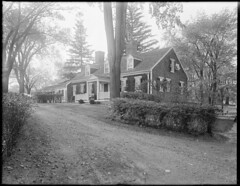Mary Sanderson and the Man in Her Bed
Mary Munroe was born in 1748 in a “part of Lexington called Scotland” for the number of Scottish immigrants who had settled there. She reportedly kept “a little of the Scottish accent…all her life.”
In October 1772, Mary Munroe married Samuel Sanderson, a cabinetmaker who had moved into town from Waltham four years before. A man who knew her later wrote that Sanderson was “reputed an excellent workman, and a man of strong, native, good sense, but of a rather phlegmatic and desponding temperament, with whom the world never wagged so cheerily as with many.”
The Sandersons had a boy named Amos in July 1774. Samuel’s brother Elijah also lived and worked with him in his house (shown here, courtesy of the Boston Public Library’s Flickr collection).
In April 1775, Samuel Sanderson was a corporal in the Lexington militia, standing on the common as the British column arrived. Local historian Michael J. Canavan recorded this story about how Mary Sanderson experienced the outbreak of war:
Despite crippling arthritis, Mary Sanderson lived to be a centenarian. On 23 Sept 1852 the women of Lexington organized a “levee” in her honor at the town hall, with refreshments and music. It raised $300. She died less than a month later at the age of 104.
In October 1772, Mary Munroe married Samuel Sanderson, a cabinetmaker who had moved into town from Waltham four years before. A man who knew her later wrote that Sanderson was “reputed an excellent workman, and a man of strong, native, good sense, but of a rather phlegmatic and desponding temperament, with whom the world never wagged so cheerily as with many.”
The Sandersons had a boy named Amos in July 1774. Samuel’s brother Elijah also lived and worked with him in his house (shown here, courtesy of the Boston Public Library’s Flickr collection).
In April 1775, Samuel Sanderson was a corporal in the Lexington militia, standing on the common as the British column arrived. Local historian Michael J. Canavan recorded this story about how Mary Sanderson experienced the outbreak of war:
When he heard that the British were coming he piloted his wife over to her father’s carrying his babe, and accompanied by a little girl who was at their house. Over at Scotland they found the mother getting breakfast and the brothers at first did not believe the report.Smart man.
After the British retreated Mary returned home and found a good many things had been stolen. Her cow (which was a good part of her marriage portion) had been killed; and a wounded British soldier was stowed away in her bed. She cried out “I wont hae him there. Why didn’t you knock him on the head?”
But the town authorities insisted he be taken care of. . . . The soldier begged for Tea but she refused. “what for should I gae him tae for? He shall hae none.”
The wounded man refused to eat or drink unless the food was tasted by some of the family.
Despite crippling arthritis, Mary Sanderson lived to be a centenarian. On 23 Sept 1852 the women of Lexington organized a “levee” in her honor at the town hall, with refreshments and music. It raised $300. She died less than a month later at the age of 104.


6 comments:
The Sanderson house (still standing and with similar street-front fenestration) is next to the
Munroe Tavern, used that day, iirc, as the field hospital and temporary hq of Percy. So not surprising finding a wounded soldier left behind. I hope the town found him other accommodations.
And it would make sense that the Sanderson house should be next to the Munroe Tavern, since Mary Sanderson was born a Munroe!
I'm intrigued by the notion that folks in that part of Lexington were speaking with a Scottish burr 250 years ago.
They were speaking with a Scottish burr because they were descendants of the Scottish prisoners of war from the Battles of Dunbar 3 Sep 1650 and Worcester 3 Sep 1651. There were several hundred Scots exiled to Massachusetts in 1650 and 1652. You can read more about them at my blog www.scotishprisonersofwar.com
Thanks for that link! (There's a typo in the URL, so folks wanting to read about the ancestor of Lexington's Monroes can go to this page.)
Mary was born 10 Oct 1748, daughter of William Munroe and Rebecca Locke (I'm both a Munroe and Locke descendant in a different line). William was the son of George Munroe and Sarah Harrington (my ancestors), the son of William Munroe, the Scots Prisoner.
Post a Comment